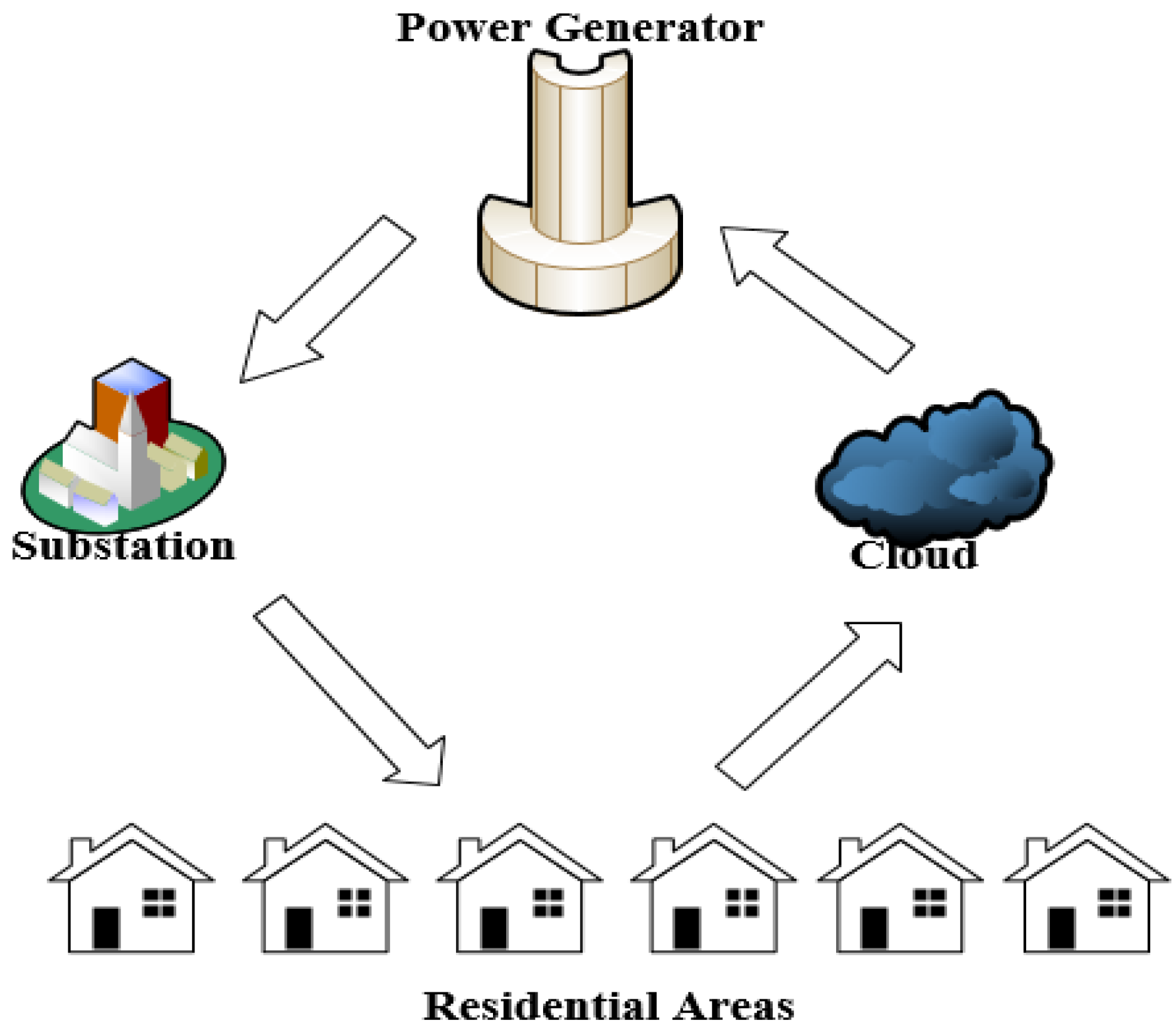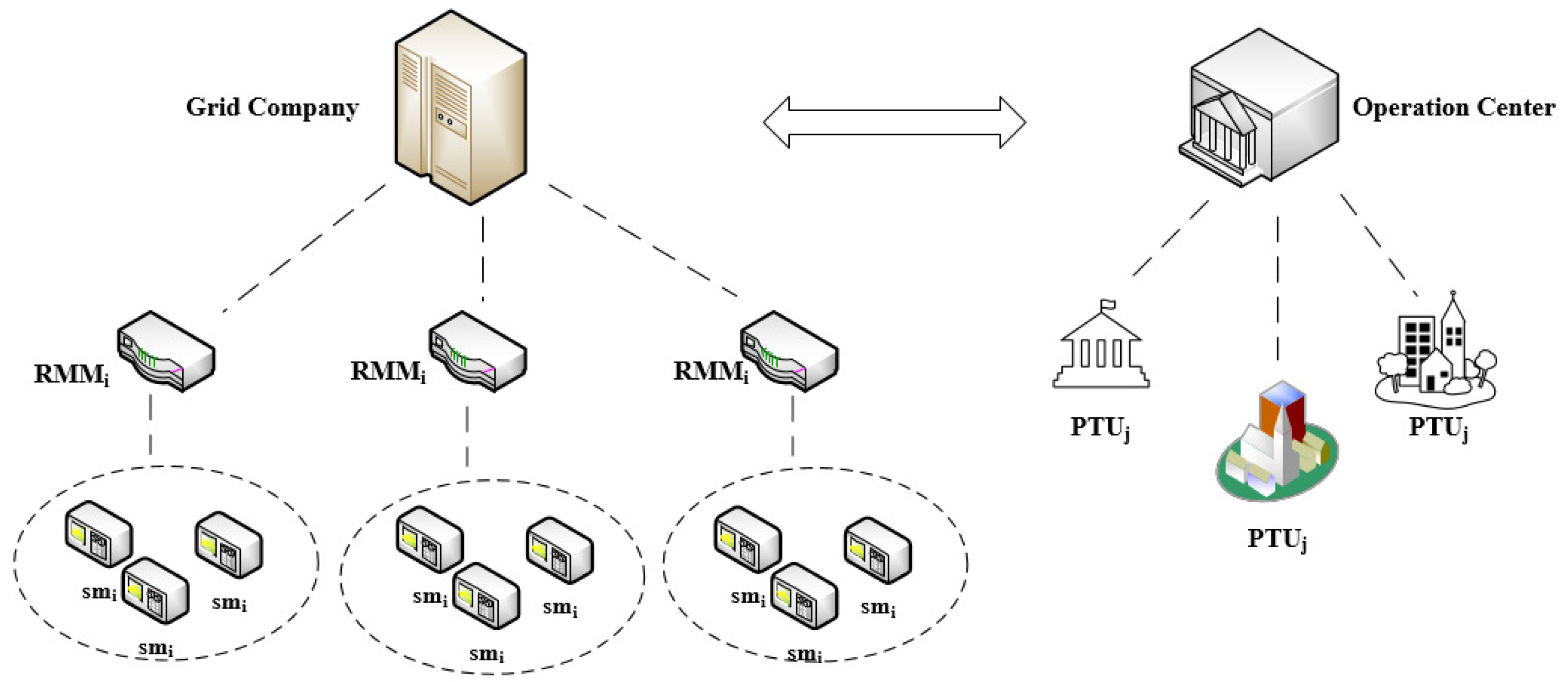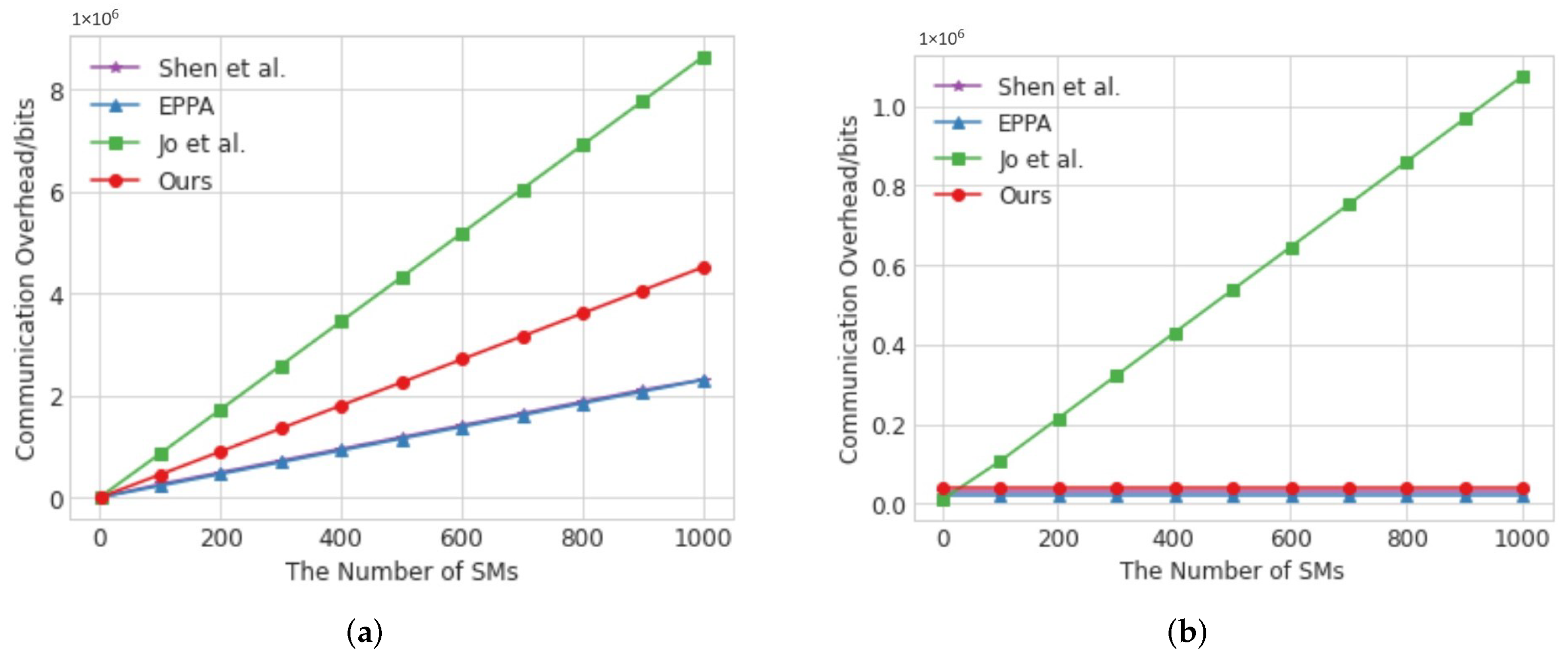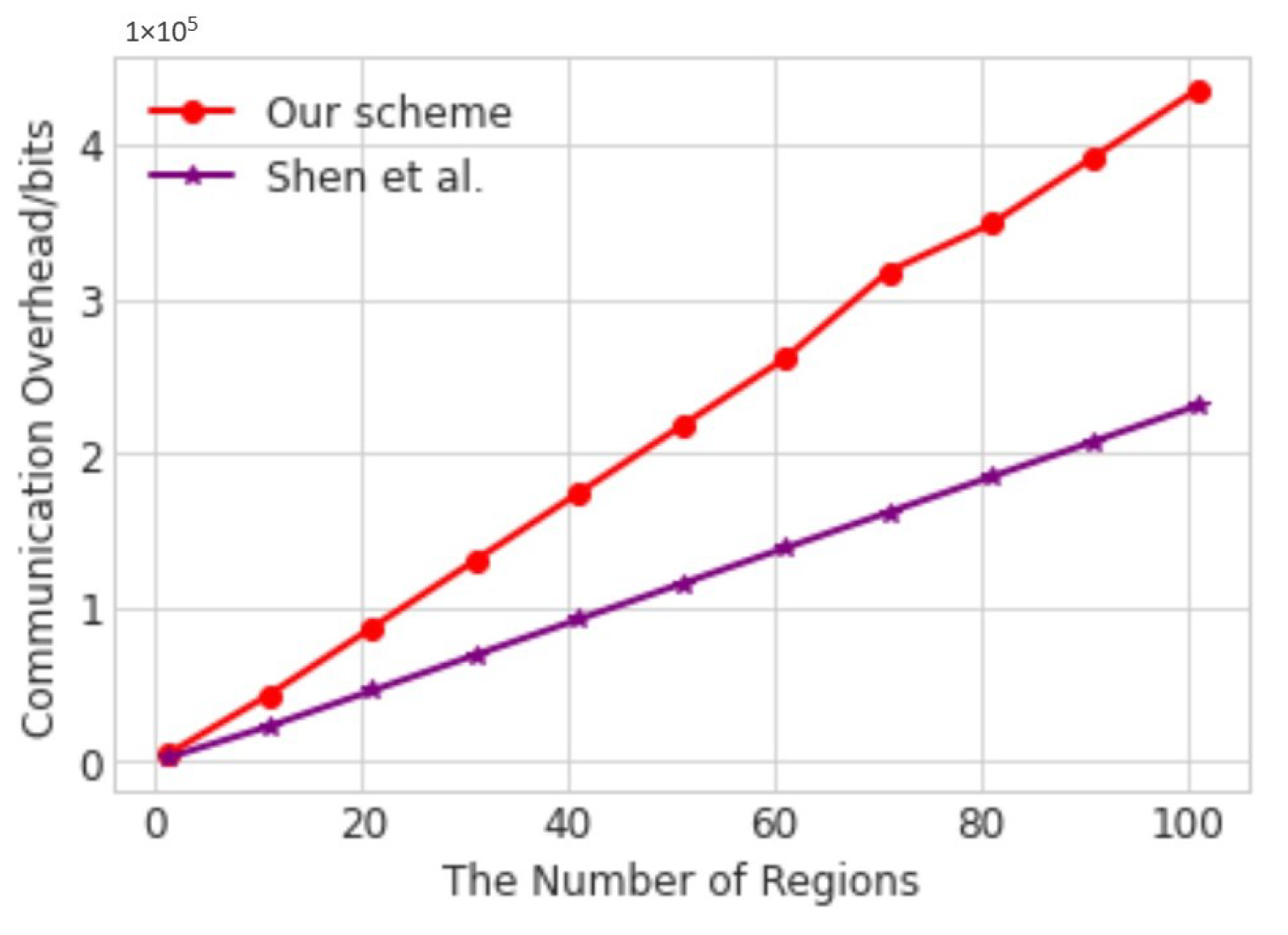Privacy Preserving Data Aggregation for Smart Grid with User Anonymity and Designated Recipients
Abstract
:1. Introduction
- Confidentiality: The data collected by the smart meters may contain users’ sensitive information. If an attacker obtains this data, users’ living habits could be leaked, so the power consumption data must be protected.
- Authentication: Power consumption data transmitted in the smart grid can be tampered with by a malicious adversary, so it is necessary to ensure that the adversary cannot modify, fabricate or delete the transmitted data without being detected.
- User anonymity: The power consumption data is normally sent with the user’s identity. When the cloud collects the data, users’ identities may be exposed to the cloud. In many circumstances, such exposure is undesirable and users’ identities should also be protected.
- No single point of trust: The decryption power should not be possessed by a single party. Otherwise, it could become a single point of trust in the system. For example, if this party is compromised, all sensitive information within the system can be read or leaked by this party. Instead, a distributed architecture should be employed.
- Designated recipients: Based on the minimum disclosure principle, fine-grained access control should be posed on the aggregated power consumption data, e.g., its access should be strictly restricted to the designated recipients.
- 1.
- Apart from the traditional security requirements, such as confidentiality and authentication, our proposed scheme also achieves user anonymity and no single point of trust. Moreover, it can ensure that the aggregated data can only be accessed by the designated recipients, realizing fine-grained access control. Therefore, it provides a more secure and flexible solution for privacy-preserving data aggregation in smart grid.
- 2.
- Security analyses prove that our scheme achieves all these desirable security requirements, and efficiency analyses demonstrate that it is efficient to be implemented in real-world applications.
2. Related Works
3. Notations and Preliminaries
3.1. Notations
3.2. Preliminaries
3.2.1. ElGamal Encryption
- Setup: Randomly choose and compute . The public key is and the private key is x.
- Encryption: Given the plaintext m, randomly choose a value and calculate the ciphertext as .
- Decryption: The entity with the private key x can decrypt the ciphertext as:
3.2.2. Schnorr Signature
- KeyGen: Randomly choose and compute . The public key is and the private key is x.
- Signing: Given the message m, the signer randomly selects and computes , and . Now, is the signature for m.
- Verifying: After receiving the signature , the verifier computes and . Then the following equation is verified:
3.2.3. Homomorphic Re-Encryption
- Setup: and are two safe primes, where and . Denote as the cyclic group of quadratic residues in , and g is a generator of .
- KeyGen: The data center and the access control server generate their public and private key pairs and . These two parties execute the Diffie-Hellman key exchange to obtain the system public key . Every designated recipient generates its public and private key pair .
- Encryption: Given a message , one randomly chooses and generates the ciphertext as
- Re-Encryption Phase I: DC chooses and publishes a computation identifier . It then computes and re-encrypt the ciphertext as
- Re-Encryption Phase II: ACS calculates after receiving . It then re-encrypts the ciphertext as
- Decryption: The designated recipient can decrypt the ciphertext aswhere .
4. Models and Definitions
4.1. System Model
- 1.
- SM: It collects user power consumption data and sends it to the RMM regularly. Note that this data needs to be sent anonymously in our proposed scheme. Moreover, each SM is assumed to contain some tamper-proof device, and its internal states can be protected.
- 2.
- RMM: It is responsible for aggregating users’ power consumption data in some regions and it will forward the aggregated result to the GC.
- 3.
- GC: Once it receives the aggregated power consumption data from the RMMs, it aggregates the received data again and then performs the first phase of proxy re-encryption.
- 4.
- OC: It executes the second phase of proxy re-encryption and sends the outputs to the designated recipients.
- 5.
- PTU: They are the designated recipients of power usage data, such as power plants and data analysts. Each of them will use its private key to decrypt the received ciphertexts.
4.2. Communication Model
4.3. Adversary Model
4.4. Security Requirements
- 1.
- Correctness: If all participants follow the protocol, it will output the correct aggregated power consumption data to the designated recipients.
- 2.
- Confidentiality: The adversary cannot learn the power consumption data of any individual user.
- 3.
- Authentication: Only data from legitimate participants will be accepted. If the data is tampered with during transmission, it can be detected.
- 4.
- User anonymity and un-linkability: The adversary cannot extract the real identities of the smart meters. Moreover, cannot link two messages that are sent by the same smart meter.
- 5.
- No single point of trust: The secret key is distributed among multiple entities, i.e., no single party can decrypt or leak sensitive information within the smart grid.
- 6.
- Designated recipients: The aggregated power consumption data can only be accessed by the designated recipients but no one else.
5. The Proposed Scheme
5.1. Initialisation
5.2. KeyGen
- 1.
- GC and OC randomly chooses and respectively as its private key. Their public and private key pairs are and .
- 2.
- Each power transmission unit generates its public and private key pair .
- 3.
- OC negotiates the key with GC to obtain the system public key:
- 4.
- Finally, the system parameters are made public.
5.3. Identity Anonymization and Encryption
- 1.
- Before smart meter sending the power consumption data to , needs to encrypt the data and hide its real identity. And generates its public and private key pair .
- 2.
- In each period, randomly chooses and calculates , . Then uses the public key PK to encrypt data and sign, , , where is the current timestamp and . Then sends the message to .
5.4. Batch Verification and Aggregation
- 1.
- Traditional verification:
- (a)
- Once the message from is received, checks the validity of first. If , will reject the message.
- (b)
- checks the validity of using the following equation:
- 2.
- Batch Verification: The above verification can be made more efficient using the small exponent test technology [37].
- (a)
- Upon receiving multiple data , sent by some , checks the freshness of , where . When the check fails, rejects the message.
- (b)
- selects a random vector , where is a small random integer in and t is a small integer. Then, verifies through the following equation:If the above equation does not hold, rejects the messages.
- 3.
- Aggregation: aggregates the encrypted data by calculating , where ℓ is the number of in the current area. Finally, sends and its corresponding signature and current timestamp to GC.
5.5. Proxy Re-Encryption
- 1.
- GC verifies the freshness and correctness of the received data and it then aggregates them:
- 2.
- The issues a request to the electricity data. After verifying that it is a legitimate designated recipient, the proxy re-encryption will be performed as follows:
- (a)
- GC calculates . Then it converts to and send it to OC, where .
- (b)
- OC calculates . Then computes and sends it to , where .
5.6. Decryption
- 1.
- first calculates
- 2.
- The aggregated electricity data M can be decrypted as follows:
- 3.
- Once obtains the aggregated power consumption data M, it can perform dynamic power distribution according to the power consumption across the area.
6. Security Analyses
6.1. Correctness
6.2. User Anonymity and Un-Linkability
6.3. Confidentiality
- 1.
- ;
- 2.
- Based on , further construct a re-encryption ciphertext , where
6.4. No Single Point of Trust
6.5. Designated Recipients
6.6. Comparison of Security Properties
7. Efficiency Analyses
7.1. Computation Costs
7.2. Communication Costs
8. Conclusions
Author Contributions
Funding
Institutional Review Board Statement
Informed Consent Statement
Data Availability Statement
Conflicts of Interest
References
- Fang, L.; Huang, L.; Zhao, Q. Discussion on megalopolis power grid safety from the perspective of Venezuelan blackout. Power Energy 2019, 40, 674–677. [Google Scholar]
- Gao, K.; Han, F.; Dong, P.; Xiong, N.; Du, R. Connected vehicle as a mobile sensor for real time queue length at signalized intersections. Sensors 2019, 19, 2059. [Google Scholar] [CrossRef] [PubMed] [Green Version]
- Arnold, G.W. Challenges and Opportunities in Smart Grid: A Position Article. Proc. IEEE. 2011, 99, 922–927. [Google Scholar] [CrossRef]
- Farhangi, H. The path of the smart grid. IEEE Power Energy Mag. 2010, 8, 18–28. [Google Scholar] [CrossRef]
- Liu, H. A Review on Development Practice of Smart Grid Technology in China. IOP Conf. Ser. Mater. Sci. Eng. 2017, 199, 012062. [Google Scholar] [CrossRef]
- Northcotegreen, J. Control and Automation of Electrical Power Distribution Systems; CRC Press: Boca Raton, FL, USA, 2007. [Google Scholar]
- Sheha, M.; Mohammadi, K.; Powell, K. Solving the duck curve in a smart grid environment using a non-cooperative game theory and dynamic pricing profiles. Energy Convers. Manag. 2020, 220, 113102. [Google Scholar] [CrossRef]
- Shen, H.; Liu, Y.; Xia, Z.; Zhang, M. An efficient aggregation scheme resisting on malicious data mining attacks for smart grid. Inf. Sci. 2020, 526, 289–300. [Google Scholar] [CrossRef]
- Yang, P.; Xiong, N.; Ren, J. Data security and privacy protection for cloud storage: A survey. IEEE Access 2020, 8, 131723–131740. [Google Scholar] [CrossRef]
- Aloqaily, M.; Boukerche, A.; Bouachir, O.; Khalid, F.; Jangsher, S. An energy trade framework using smart contracts: Overview and challenges. IEEE Netw. 2020, 34, 119–125. [Google Scholar] [CrossRef]
- Lopez, J.; Rubio, J.E.; Alcaraz, C. A resilient architecture for the smart grid. IEEE Trans. Ind. Inform. 2018, 14, 3745–3753. [Google Scholar] [CrossRef]
- Serrano, D.; Ruíz, J.F.; Muñoz, A.; Maña, A.; Armenteros, A.; Crespo, B.G.N. Development of applications based on security patterns. In Proceedings of the 2009 Second International Conference on Dependability, Athens, Greece, 18–23 June 2009; pp. 111–116. [Google Scholar]
- Sánchez-Cid, F.; Mana, A.; Spanoudakis, G.; Kloukinas, C.; Serrano, D.; Munoz, A. Representation of security and dependability solutions. In Security and Dependability for Ambient Intelligence; Springer: Boston, MA, USA, 2009; pp. 69–95. [Google Scholar]
- Li, S.; Xue, K.; Yang, Q.; Hong, P. PPMA: Privacy-preserving multi-subset aggregation in smart grid. IEEE Trans. Ind. Informat. 2018, 14, 462–471. [Google Scholar] [CrossRef]
- Zhang, J.; Zhao, Y.; Wu, J.; Chen, B. LVPDA: A lightweight and verifiable privacy-preserving data aggregation scheme for edge-enabled IoT. IEEE Internet Things J. 2020, 7, 4016–4027. [Google Scholar] [CrossRef]
- Ding, Y.; Wang, B.; Wang, Y.; Zhang, K.; Wang, H. Secure metering data aggregation with batch verification in industrial smart grid. IEEE Trans. Ind. Inform. 2020, 16, 6607–6616. [Google Scholar] [CrossRef]
- Paillier, P. Public-key cryptosystems based on composite degree residuosity classes. In International Conference on the Theory and Applications of Cryptographic Techniques; Springer: New York, NY, USA, 1999; pp. 223–238. [Google Scholar]
- Lu, R.; Liang, X.; Li, X.; Lin, X.; Shen, X. EPPA: An efficient and privacy preserving aggregation scheme for secure smart grid communications. IEEE Trans. Parallel Distrib. Syst. 2012, 23, 1621–1631. [Google Scholar]
- Shen, H.; Zhang, M.; Wang, H. A lightweight privacy-preserving fair meeting location determination scheme. IEEE Internet Things J. 2020, 7, 3083–3093. [Google Scholar] [CrossRef] [Green Version]
- Ding, W.; Yan, Z.; Deng, R.H. Encrypted data processing with homomorphic re-encryption. Inf. Sci. 2017, 409, 35–55. [Google Scholar] [CrossRef]
- Guan, Z.; Zhang, Y.; Zhu, L.; Wu, L.; Yu, S. EFFECT: An efficient flexible privacy-preserving data aggregation scheme with authentication in smart grid. Sci. China Inf. Sci. 2019, 62, 32103. [Google Scholar] [CrossRef] [Green Version]
- Li, H.; Lin, X.; Yang, H.; Liang, X.; Lu, R.; Shen, X. EPPDR: An efficient privacy-preserving demand response scheme with adaptive key evolution in smart grid. IEEE Trans. Parallel Distrib. Syst. 2014, 25, 2053–2064. [Google Scholar] [CrossRef] [Green Version]
- Zhang, M.; Chen, Y.; Lin, J. A privacy-preserving optimization of neighborhood-based recommendation for medical-aided diagnosis and treatment. IEEE Internet Things J. 2021, 8, 10830–10842. [Google Scholar] [CrossRef]
- Zhang, M.; Chen, Y.; Xia, Z.; Du, J.; Susilo, W. PPO-DFK a privacy-preserving optimization of distributed fractional knapsack with application in secure footballer configurations. IEEE Syst. J. 2020, 15, 759–770. [Google Scholar] [CrossRef]
- Liu, Y.; Guo, W.; Fan, C.; Chang, L.; Cheng, C. A practical privacy-preserving data aggregation (3pda) scheme for smart grid. IEEE Trans. Ind. Inf. 2019, 15, 1767–1774. [Google Scholar] [CrossRef]
- Xue, K.; Zhu, B.; Yang, Q.; Wei, D.S.L.; Guizani, M. An efficient and robust data aggregation scheme without a trusted authority for smart grid. IEEE Internet Things J. 2020, 7, 1949–1959. [Google Scholar] [CrossRef]
- Zhao, S.; Li, F.; Li, H.; Lu, R.; Ren, S.; Bao, H.; Lin, J.H.; Han, S. Smart and practical privacy-preserving data aggregation for fog-based smart grids. IEEE Trans. Inf. Forensics Secur. 2021, 16, 521–536. [Google Scholar] [CrossRef]
- Su, Y.; Li, Y.; Li, J.; Zhang, K. LCEDA: Lightweight and Communication-Efficient Data Aggregation Scheme for Smart Grid. IEEE Internet Things J. 2021, 8, 15639–15648. [Google Scholar] [CrossRef]
- Huang, C.; Wang, X.; Gan, Q.; Huang, D.; Yao, M.; Lin, Y. A lightweight and fault-tolerable data aggregation scheme for privacy-friendly smart grids environment. Clust. Comput. 2021, 24, 3495–3514. [Google Scholar] [CrossRef]
- Xu, C.; Zhang, L.; Zhu, L.; Zhang, C.; Du, X.; Guizani, M.; Sharif, K. Aggregate in my way: Privacy-preserving data aggregation without trusted authority in ICN. Future Gener. Comput. Syst. 2020, 111, 107–116. [Google Scholar] [CrossRef]
- Tan, X.; Zheng, J.; Zou, C.; Niu, Y. Pseudonym-based privacy-preserving scheme for data collection in smart grid. Int. J. Hoc Ubiquitous Comput. 2016, 22, 120–127. [Google Scholar] [CrossRef]
- Guan, Z.; Si, G.; Zhang, X. Privacy-preserving and Efficient Aggregation based on Blockchain for Power Grid Communications in Smart Communities. IEEE Commun. Mag. 2018, 56, 82–88. [Google Scholar] [CrossRef] [Green Version]
- Liu, X.; Zhang, Y.; Wang, B.; Wang, H. An anonymous data aggregation scheme for smart grid systems. Secur. Commun. Netw. 2014, 7, 602–610. [Google Scholar] [CrossRef]
- Sui, Z.; Alyousef, A.; de Meer, H. IAA: Incentive-based anonymous authentication scheme in smart grids. In International Conference on Internet Science; Springer: Cham, Switzerland, 2015; pp. 133–144. [Google Scholar]
- Yu, C.; Chen, C.; Kuo, S.; Chao, H. Privacy-preserving power request in smart grid networks. IEEE Syst. J. 2013, 8, 441–449. [Google Scholar] [CrossRef]
- Cheung, J.; Chim, T.; Yiu, S.; Hui, L. Credential-Based Privacy-Preserving Power Request Scheme for Smart Grid Network. In Proceedings of the IEEE Global Telecommunications Conference, Houston, TX, USA, 5–9 December 2011; pp. 1–5. [Google Scholar] [CrossRef] [Green Version]
- Hornget, S. b-SPECS+: Batch verification for secure pseudonymous authentication in VANET. IEEE Trans. Inf. Forensics Secur. 2013, 8, 1860–1875. [Google Scholar] [CrossRef]
- Bresson, E.; Catalano, D.; Pointcheval, D. A simple public-key cryptosystem with a double trapdoor decryption mechanism and its applications. In Advances in Cryptology-ASIACRYPT; Springer: Berlin/Heidelberg, Germany, 2003; pp. 37–54. [Google Scholar]
- Shen, H.; Zhang, M.; Shen, J. Efficient privacy-preserving cube-data aggregation scheme for smart grids. IEEE Trans. Inf. Forensics Secur. 2017, 12, 1369–1381. [Google Scholar] [CrossRef]
- Jo, H.; Kim, I.; Lee, D. Efficient and Privacy-Preserving Metering Protocols for Smart Grid Systems. IEEE Trans. Smart Grid 2016, 7, 1732–1742. [Google Scholar] [CrossRef]




| Notations | Meaning |
|---|---|
| p,q | Two large primes such that q|p–1 |
| G | A finite cyclic group with order q |
| g | The generator of group G |
| A multiplicative group modulo p | |
| H | A collision resistant hash function |
| PK | The public key |
| mi | User’s power consumption data |
| Mi | The power consumption data recorded by RMMi |
| M | The total amount of power usage across all areas |
| ℓ,S | The number of SMi in each area and RMMi |
| RID | The smart meter’s real identity |
| T* | The current time stamp of the RMMi |
| ΔT | The allowed time delay in the system |
| CID | Computation identifier |
| L(*) | Bit length of the input data |
| || | The message concatenation operation |
Publisher’s Note: MDPI stays neutral with regard to jurisdictional claims in published maps and institutional affiliations. |
© 2022 by the authors. Licensee MDPI, Basel, Switzerland. This article is an open access article distributed under the terms and conditions of the Creative Commons Attribution (CC BY) license (https://creativecommons.org/licenses/by/4.0/).
Share and Cite
Wu, L.; Zhang, W.; Zhao, W. Privacy Preserving Data Aggregation for Smart Grid with User Anonymity and Designated Recipients. Symmetry 2022, 14, 847. https://doi.org/10.3390/sym14050847
Wu L, Zhang W, Zhao W. Privacy Preserving Data Aggregation for Smart Grid with User Anonymity and Designated Recipients. Symmetry. 2022; 14(5):847. https://doi.org/10.3390/sym14050847
Chicago/Turabian StyleWu, Liang, Wenzheng Zhang, and Wei Zhao. 2022. "Privacy Preserving Data Aggregation for Smart Grid with User Anonymity and Designated Recipients" Symmetry 14, no. 5: 847. https://doi.org/10.3390/sym14050847
APA StyleWu, L., Zhang, W., & Zhao, W. (2022). Privacy Preserving Data Aggregation for Smart Grid with User Anonymity and Designated Recipients. Symmetry, 14(5), 847. https://doi.org/10.3390/sym14050847





